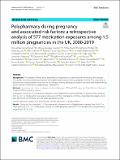Polypharmacy during pregnancy and associated risk factors : a retrospective analysis of 577 medication exposures among 1.5 million pregnancies in the UK, 2000-2019
Abstract
Background The number of medications prescribed during pregnancy has increased over the past few decades. Few studies have described the prevalence of multiple medication use among pregnant women. This study aims to describe the overall prevalence over the last two decades among all pregnant women and those with multimorbidity and to identify risk factors for polypharmacy in pregnancy. Methods A retrospective cohort study was conducted between 2000 and 2019 using the Clinical Practice Research Datalink (CPRD) pregnancy register. Prescription records for 577 medication categories were obtained. Prevalence estimates for polypharmacy (ranging from 2+ to 11+ medications) were presented along with the medications commonly prescribed individually and in pairs during the first trimester and the entire pregnancy period. Logistic regression models were performed to identify risk factors for polypharmacy. Results During the first trimester (812,354 pregnancies), the prevalence of polypharmacy ranged from 24.6% (2+ medications) to 0.1% (11+ medications). During the entire pregnancy period (774,247 pregnancies), the prevalence ranged from 58.7 to 1.4%. Broad-spectrum penicillin (6.6%), compound analgesics (4.5%) and treatment of candidiasis (4.3%) were commonly prescribed. Pairs of medication prescribed to manage different long-term conditions commonly included selective beta 2 agonists or selective serotonin re-uptake inhibitors (SSRIs). Risk factors for being prescribed 2+ medications during the first trimester of pregnancy include being overweight or obese [aOR: 1.16 (1.14–1.18) and 1.55 (1.53–1.57)], belonging to an ethnic minority group [aOR: 2.40 (2.33–2.47), 1.71 (1.65–1.76), 1.41 (1.35–1.47) and 1.39 (1.30–1.49) among women from South Asian, Black, other and mixed ethnicities compared to white women] and smoking or previously smoking [aOR: 1.19 (1.18–1.20) and 1.05 (1.03–1.06)]. Higher and lower age, higher gravidity, increasing number of comorbidities and increasing level of deprivation were also associated with increased odds of polypharmacy. Conclusions The prevalence of polypharmacy during pregnancy has increased over the past two decades and is particularly high in younger and older women; women with high BMI, smokers and ex-smokers; and women with multimorbidity, higher gravidity and higher levels of deprivation. Well-conducted pharmaco-epidemiological research is needed to understand the effects of multiple medication use on the developing foetus.
Citation
Subramanian , A , Azcoaga-Lorenzo , A , Anand , A , Phillips , K , Lee , S I , Cockburn , N , Fagbamigbe , A , Damase-Michel , C , Yau , C , McCowan , C , O’Reilly , D , Santorelli , G , Hope , H , Kennedy , J I , Abel , K M , Eastwood , K-A , Locock , L , Black , M , Loane , M , Moss , N , Plachcinski , R , Thangaratinam , S , Brophy , S , Agrawal , U , Vowles , Z , Brocklehurst , P , Dolk , H , Nelson-Piercy , C , Nirantharakumar , K & MuM-PreDiCT Group 2023 , ' Polypharmacy during pregnancy and associated risk factors : a retrospective analysis of 577 medication exposures among 1.5 million pregnancies in the UK, 2000-2019 ' , BMC Medicine , vol. 21 , 21 . https://doi.org/10.1186/s12916-022-02722-5
Publication
BMC Medicine
Status
Peer reviewed
ISSN
1741-7015Type
Journal article
Description
Funding: This work was funded by the Strategic Priority Fund “Tackling multimorbidity at scale” programme [grant number MR/W014432/1] delivered by the Medical Research Council and the National Institute for Health Research in partnership with the Economic and Social Research Council and in collaboration with the Engineering and Physical Sciences Research Council. BT was funded by the National Institute for Health Research (NIHR) West Midlands Applied Research Collaboration. AA, KP and SIL were funded as NIHR Academic Clinical Fellows.Collections
Items in the St Andrews Research Repository are protected by copyright, with all rights reserved, unless otherwise indicated.

